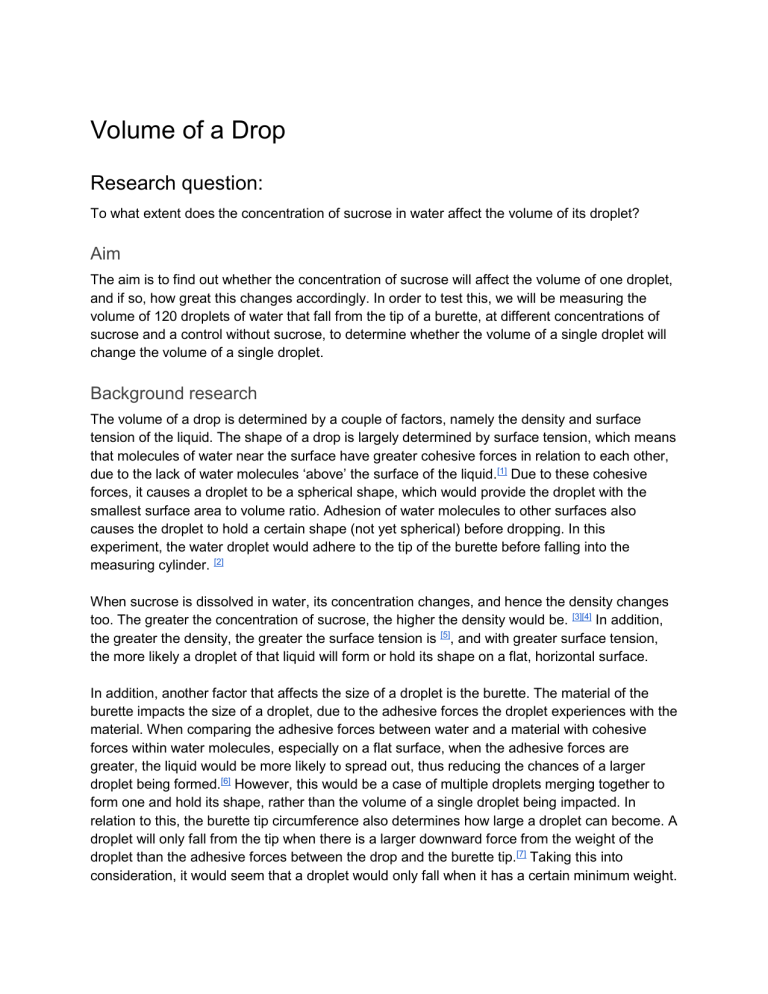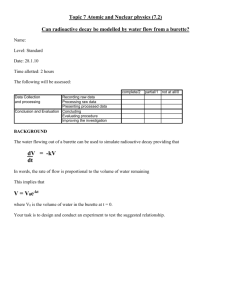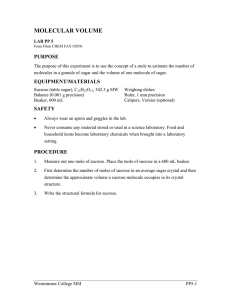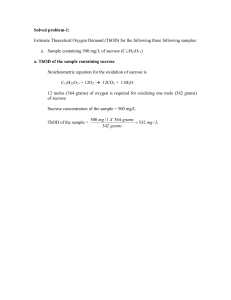
Volume of a Drop Research question: To what extent does the concentration of sucrose in water affect the volume of its droplet? Aim The aim is to find out whether the concentration of sucrose will affect the volume of one droplet, and if so, how great this changes accordingly. In order to test this, we will be measuring the volume of 120 droplets of water that fall from the tip of a burette, at different concentrations of sucrose and a control without sucrose, to determine whether the volume of a single droplet will change the volume of a single droplet. Background research The volume of a drop is determined by a couple of factors, namely the density and surface tension of the liquid. The shape of a drop is largely determined by surface tension, which means that molecules of water near the surface have greater cohesive forces in relation to each other, due to the lack of water molecules ‘above’ the surface of the liquid.[1] Due to these cohesive forces, it causes a droplet to be a spherical shape, which would provide the droplet with the smallest surface area to volume ratio. Adhesion of water molecules to other surfaces also causes the droplet to hold a certain shape (not yet spherical) before dropping. In this experiment, the water droplet would adhere to the tip of the burette before falling into the measuring cylinder. [2] When sucrose is dissolved in water, its concentration changes, and hence the density changes too. The greater the concentration of sucrose, the higher the density would be. [3][4] In addition, the greater the density, the greater the surface tension is [5], and with greater surface tension, the more likely a droplet of that liquid will form or hold its shape on a flat, horizontal surface. In addition, another factor that affects the size of a droplet is the burette. The material of the burette impacts the size of a droplet, due to the adhesive forces the droplet experiences with the material. When comparing the adhesive forces between water and a material with cohesive forces within water molecules, especially on a flat surface, when the adhesive forces are greater, the liquid would be more likely to spread out, thus reducing the chances of a larger droplet being formed.[6] However, this would be a case of multiple droplets merging together to form one and hold its shape, rather than the volume of a single droplet being impacted. In relation to this, the burette tip circumference also determines how large a droplet can become. A droplet will only fall from the tip when there is a larger downward force from the weight of the droplet than the adhesive forces between the drop and the burette tip.[7] Taking this into consideration, it would seem that a droplet would only fall when it has a certain minimum weight. Based on the equation 𝑑𝑒𝑛𝑠𝑖𝑡𝑦 = 𝑚𝑎𝑠𝑠 , 𝑣𝑜𝑙𝑢𝑚𝑒 in which mass would be a constant (due to a specific weight of the drop being necessary for it to fall), it would suggest that the volume of a drop will be greater when the density is lower (ie with a lower concentration of sucrose). Method, apparatus Refer to instruction sheet Analysis Raw data Table 1: raw data showing the raw data collected (ie volume of 120 drops across several trials at different masses of sucrose used) Volume 120 drops (cm³) +/- 0.1cm³ Mass sucrose (g) +/- 0.002g Volume water/cm³ +/0.12cm³ Trial 1 Trial 2 Trial 3 Trial 4 Trial 5 0.000 50.00 6.6 6.0 6.0 6.6 6.4 2.000 50.00 6.2 6.2 6.2 * 4.000 50.00 6.2 6.2 6.2 6.000 50.00 6.2 6.2 6.2 8.000 50.00 6.2 6.0 6.0 6.2 6.0 Observations: ● Measuring cylinder (used to collect drops) were slightly wet before the drops were added ● Burette wasn’t always dry before the solution was poured inside, which could impact the concentration of the solution ● The first trial at 0.00g/cm³ solution was done on a separate day as the rest, likely with a different burette ● First few drops observed were very fast ● When a new solution of sucrose was added to the burette, there would be some air bubbles when the solution came out ● Total volume not always entirely at the line of the measurement, but very close ● * 4th and 5th trials for 2, 4, 6g sucrose not taken Data processing Table 2: data processing table showing the concentration and corresponding average volumes for 120 and 1 drop of solution For 2.000g sucrose: 𝑚𝑎𝑠𝑠 𝑜𝑓 𝑠𝑢𝑐𝑟𝑜𝑠𝑒 Concentration of solution: 𝑣𝑜𝑙𝑢𝑚𝑒 𝑜𝑓 𝑤𝑎𝑡𝑒𝑟 = Average volume 120 drops: Average volume 1 drop: 𝑡𝑜𝑡𝑎𝑙 𝑡𝑟𝑖𝑎𝑙𝑠 2.000 = 0.04 50 6.2+6.2+6.2 = 𝑛𝑢𝑚𝑏𝑒𝑟 𝑜𝑓 𝑡𝑟𝑖𝑎𝑙𝑠 𝑎𝑣𝑒𝑟𝑎𝑔𝑒 𝑣𝑜𝑙𝑢𝑚𝑒 120 𝑑𝑟𝑜𝑝𝑠 120 3 6.2 = 6.2 = 120 = 0.052 Concentration/g/cm³ Average volume 120 drops (+/- 0.1) cm³ Average volume 1 drop (+/8.3 × 10−4) cm³ 0.00 6.3 5.3 × 10−2 0.04 6.2 5.2 × 10−2 0.08 6.2 5.2 × 10−2 0.12 6.2 5.2 × 10−2 0.16 6.1 5.1 × 10−2 Table 3.1: data processing table showing uncertainties the concentration of sucrose solution (independent variable) For 0.04g/cm³ solution: % uncertainty of concentration: 𝑎𝑏𝑠𝑜𝑙𝑢𝑡𝑒 𝑢𝑛𝑐𝑒𝑟𝑡𝑎𝑖𝑛𝑡𝑦 (𝑚𝑎𝑠𝑠 𝑜𝑓 𝑠𝑢𝑐𝑟𝑜𝑠𝑒) 𝑎𝑏𝑠𝑜𝑙𝑢𝑡𝑒 𝑢𝑛𝑐𝑒𝑟𝑡𝑎𝑖𝑛𝑡𝑦 (𝑣𝑜𝑙𝑢𝑚𝑒 𝑤𝑎𝑡𝑒𝑟) 𝑣𝑜𝑙𝑢𝑚𝑒 𝑤𝑎𝑡𝑒𝑟 × 100 = 𝑚𝑎𝑠𝑠 𝑜𝑓 𝑠𝑢𝑐𝑟𝑜𝑠𝑒 0.002 0.12 2 × 100 + 50 × 100 + × 100 = 0.34 * absolute uncertainty of mass is 0.002 due to uncertainty to tare the scale as well as taking the mass of the sucrose (each 0.001g) ** due to variations in uncertainties based on different masses used for each concentration, it couldn’t be displayed on the graph Concentration /g/cm³ % uncertainty sucrose mass % uncertainty water volume % total uncertainty Absolute uncertainty concentration/g/cm³ 0.00 0 0.24 0.24 0 0.04 0.1 0.24 0.34 1.4 × 10−4 0.08 0.05 0.24 0.29 2.3 × 10−4 0.12 0.03 0.24 0.27 3.2 × 10−4 0.16 0.03 0.24 0.27 4.3 × 10−4 Table 3.2: data processing table showing uncertainties for the volume of a drop (dependent variable) % uncertainty volume: 0.1 𝑎𝑏𝑠𝑜𝑙𝑢𝑡𝑒 𝑢𝑛𝑐𝑒𝑟𝑡𝑎𝑖𝑛𝑡𝑦 (𝑚𝑒𝑎𝑠𝑢𝑟𝑖𝑛𝑔 𝑐𝑦𝑙𝑖𝑛𝑑𝑒𝑟) 𝑣𝑜𝑙𝑢𝑚𝑒 120 𝑑𝑟𝑜𝑝𝑠 × 100 + 𝑢𝑛𝑐𝑒𝑟𝑡𝑎𝑖𝑛𝑡𝑦 (𝑐𝑜𝑢𝑛𝑡𝑖𝑛𝑔) 𝑛𝑢𝑚𝑏𝑒𝑟 𝑜𝑓 𝑑𝑟𝑜𝑝𝑠 × 2 100 = 6.2 × 100 + 120 × 100 = 3.3 * taking uncertainty of volume using 𝑚𝑎𝑥−𝑚𝑖𝑛 2 would not be relevant as it would mean 0 uncertainty for results for which all trials had the same result, therefore uncertainty is taken as 0.1cm³ as this is the uncertainty of the measuring cylinder used ** % uncertainty for one drop is the same as that for 120 drops (as it’s a percentage), so % uncertainty is taken from the values measured, not the calculated values (ie using volume of 120 instead of 1 drop to find the % uncertainty) *** although the average mass of 120 drops vary slightly, the % uncertainty all round to the same when rounded to 2 s.f. **** absolute uncertainty for counting the number of drops is taken as +/- 2 drops Concentration/ g/cm³ Volume 1 drop/cm³ % uncertainty Absolute uncertainty/drop 0.00 5.3 × 10−2 3.3 1.7 × 10−3 0.04 5.2 × 10−2 3.3 1.7 × 10−3 0.08 5.2 × 10−2 3.3 1.7 × 10−3 0.12 5.2 × 10−2 3.3 1.7 × 10−3 0.16 5.1 × 10−2 3.3 1.7 × 10−3 Graphs This graph shows the data (average volume of 1 drop against sucrose concentration). The error bars for sucrose concentration weren’t possible to add in, as the % uncertainty for each value varied, and the system only enabled a constant uncertainty as input. This is the same graph as above, but with a smaller scale on the y-axis, to show the trendline better with regards to the results. This graph does make the error seem much bigger and the trend more significant, but that is simply a result of using a much smaller scale. Conclusion The results point towards the idea that as sucrose concentration increases, the mass of the volume decreases very slightly, as followed by the trendline. However, from the average (mean, median and modal) result of the volume of 1 drop, through combining all concentrations, it indicates that the volume of one drop is largely unaffected by the concentration of sucrose, based on the insubstantial changes in volume. The graph’s correlation coefficient is -0.77, which is not very close to -1, the ideal value to measure the correlation between the two variables with a negative correlation. From this value, the coefficient of determination would be 0.59, thus showing that the regression line is not a good representation of our results as there is no significant correlation between the two variables. Thus, our results were not very relevant in determining the impact of sucrose concentration on drop volume, as the line is essentially almost completely horizontal, pointing towards the idea that concentration doesn’t affect droplet size. This correlation coefficient also points towards a number of errors being made. One of the most significant factors would be the inability to measure the exact volume of 120 drops. When we took the measurements (eg the 6.2cm³ values), the meniscus was not always exactly at the 6.2 level. While this may not be very significant in measuring 6.2cm³ of solution, it would impact the calculated volume of a drop, as one drop is very small. Another factor that could have influenced this level would be the fact that the measuring cylinder may not always have been completely dry before drops were added. More errors, and their improvements are highlighted below. With regards to the background knowledge, the results show a vague similarity, in the sense that a lower concentration of sucrose (and hence lower density) had a larger volume per drop than solutions with higher sucrose concentrations. However, once again, the difference between the volume of each drop at different concentrations were quite insignificant, thus showing that there was a high level of error made in the experiment. Despite this, we were able to show that a droplet would only fall when it had a certain mass, otherwise it would simply hang from the tip of the burette (eg when water was added very slowly). Overall, though, our results did not align with the background context regarding density and surface tension of a liquid and how these factors interact with a burette to determine the volume of a drop. Evaluation Table 4.1: evaluation table showing strengths and their significance from the experiment Strength Significance Use of volumetric flask to measure volume of water This allows for a much more accurate measurement of the volume of water as compared to equipment like a measuring cylinder Use of scale with high precision The scale used went up to 3dp, which allows for a precise value of the mass in order to reduce uncertainties from the mass measured Use of a control (test with no sucrose) We carried out a test to find the volume of a drop without any sucrose dissolved in it, to determine whether sucrose affected the volume in the first place Repeats (3-5 times) The use of many repeats helps to reduce the random error in the experiment, and allows us to identify any anomalous results (if any) Table 4.2: evaluation table showing limitations, their significance and possible improvements Limitation Significance Improvement Measuring cylinder slightly wet before drops were added. Since the aim was to measure the volume of a single drop, the water in the measuring cylinder would lead to less accurate results, as a greater volume of solution would be measured. Dry the measuring cylinder each time before counting droplets, such as by using a paper towel to dry the inside. Using a different burette for the first trial as compared to the rest. Each burette is slightly different, so the size of each droplet may vary from one burette to the other, causing a different total volume due to the varying sizes of droplets. Try to collect all the data on the same day to ensure the burette used is the same, or alternatively label the burette such that the same one will be used the next time round. First few drops from the burette were added very quickly; counting 120 droplets. When the droplets were added to the measuring cylinder quickly, it was hard to accurately take note of how many drops had fallen. The speed of which the droplets fell could also have impacted the volume of each drop. It was also tedious to count 120 droplets properly, so there could’ve been uncertainties regarding For the first few droplets, it could be better to open the burette really slowly each time, to ensure that the falling drops are easy to count. When taking into account inaccuracies of counting the droplets, we adopted a method to count to 20 6 times, so as to make the counting process easier. To count exactly 120 drops, we whether or not it was exactly 120 droplets that fell. could also use a counter, which would likely be more accurate than humans. Air bubbles at the start of the first trials When there were air bubbles, it was sometimes difficult to differentiate between a water droplet and an air bubble with a tiny bit of water surrounding it, which could eventually make the volume seem lower than it actually was. When we realised the problem with air bubbles, we would open the burette until a normal stream of water would be released, after which we close the burette, poured that solution away, and started counting the droplets from 0. Errors in determining the concentration of sucrose We added a specific mass of sucrose to a beaker with some distilled water and stirred until the sucrose dissolved, after which we poured that into the volumetric flask and added more distilled water until it reached the 50cm³ mark. However, this provides inaccuracies with regards to the concentration of sucrose, because a large mass of sucrose would likely mean a smaller volume of water used (since we only added water until 50cm³), and thus, the calculated concentration of sucrose would’ve been lower than the actual value. To calculate the concentration accurately, we would need to ensure that the volume of water used, that a set mass of sucrose was dissolved, in was constant. In this case, it could be better to measure out 50cm³ distilled water using the volumetric flask, and pouring this into a beaker to dissolve the sucrose into. Then, the solution would be poured back into the volumetric flask until 50cm³ of solution was used. Then, with a constant, specific volume of water used, you would be able to calculate the actual concentration of the solution more accurately. Different people counted for different trials Since people may have different types of consistent, systematic errors, having different people count the droplets can lead to inconsistencies in the results, leading to a reduced level of precision. Having the same person count each time will help to reduce this source of error. Alternatively, an electronic counter can be used to provide more accuracy. Improvements and extension Based on the conclusion and evaluation of our methodology, it is clear that we experienced a handful of errors that impacted our results. In terms of random error, it was quite low due to our use of precise equipment and repeated trials, but it would be better if we did at least 5 trials for all concentrations of sucrose, rather than just 2. With regards to the systematic errors, the improvements possible are highlighted in the table above, so it would be better to repeat the experiment again by taking those changes into account the next time round. This could help to compare results to the original experiment done, to see how similar the results turn out to be. In addition, repeating the experiment would also allow us to test the reproducibility of the method, as it could show us if similar results or trends can be found when the experiment is done again at a separate point in time using the same method and taking improvements into account. Bibliography USGS, Surface Tension and Water. Retrieved Jan 29 2021 from: https://www.usgs.gov/specialtopic/water-science-school/science/surface-tension-and-water?qt-science_center_objects=0#qtscience_center_objects R Nave Hyperphysics, Surface Tension and Bubbles. Retrieved Jan 29 2021 from: http://hyperphysics.phy-astr.gsu.edu/hbase/surten2.html#c3 Gayle Towell (2020, Dec 28) Continuity Equation (Fluids): Definition, Forms and Examples. Retrieved Jan 29 2021 from: (https://sciencing.com/continuity-equation-fluids-definition-formsexamples-13723387.html) Libretexts (2020, Aug 18). Sugar Solution Density. Retrieved Jan 30 2021 from:https://chem.libretexts.org/Ancillary_Materials/Exemplars_and_Case_Studies/Exemplars/F oods/Sugar_Solution_Density Fred Senese (2018, Feb 23) What factors affect the size of fluid drops exiting a dropper or burette? Retrieved Jan 30 2021 from: https://antoine.frostburg.edu/chem/senese/101/liquids/faq/tates-law.shtml Pia-Maria Bododea (2007) Surface Tension: The Relationship between Surface Tension and Density of a Liquid. Retrieved Jan 30 2021 from: https://csef.usc.edu/History/2007/Projects/J1603.pdf Chem Purdue University, Surface Tension/ Retrieved Jan 2021 from: https://www.chem.purdue.edu/gchelp/liquids/tension.html



